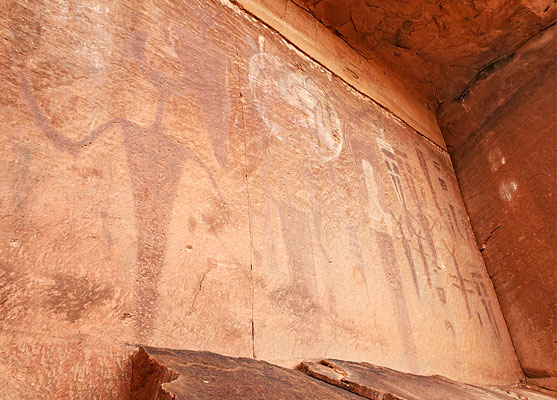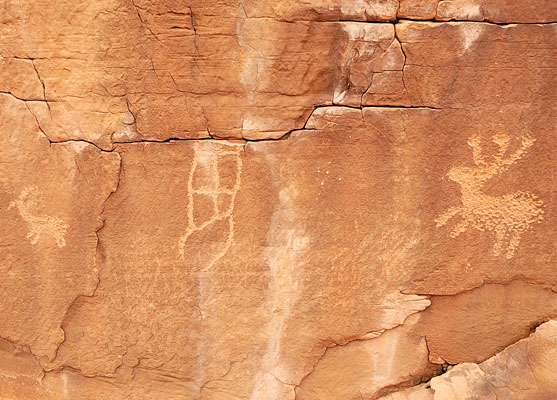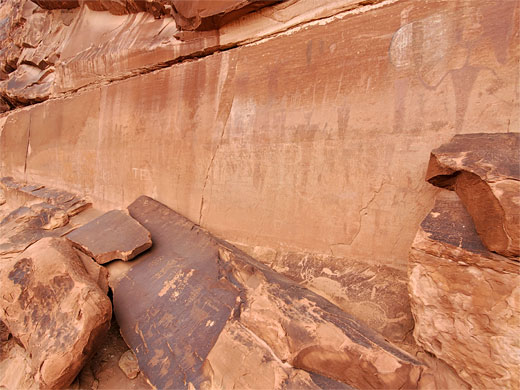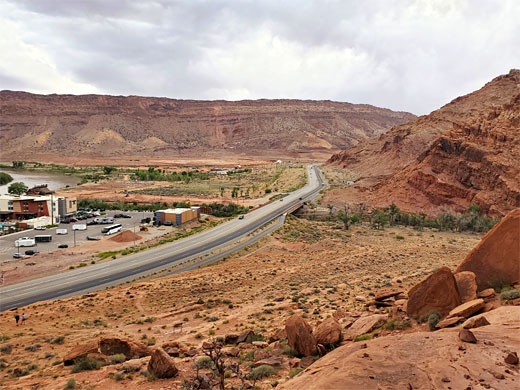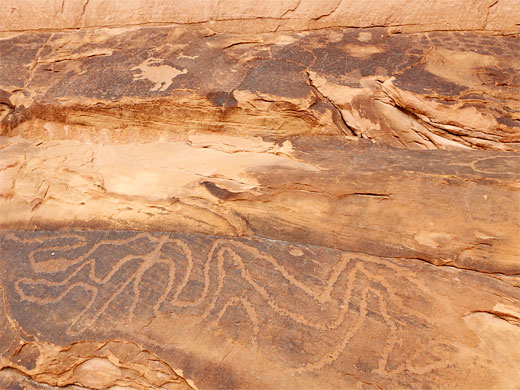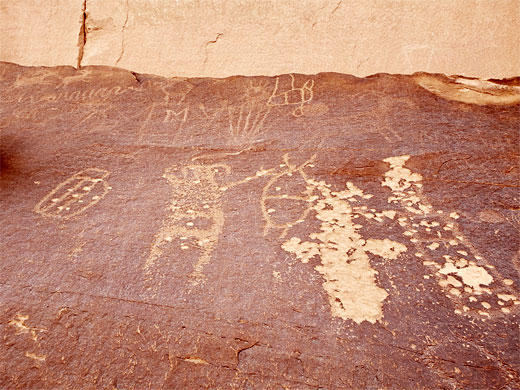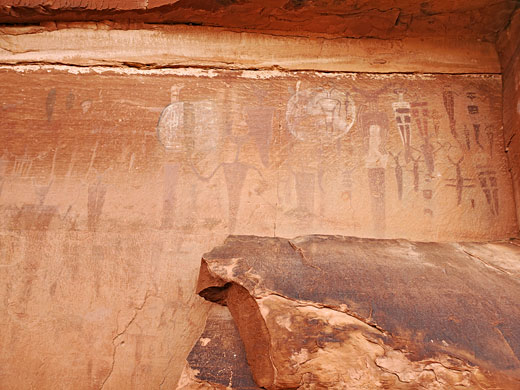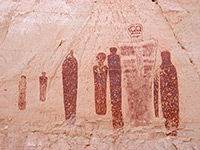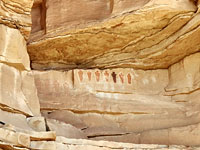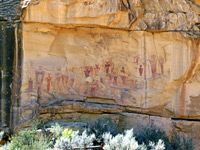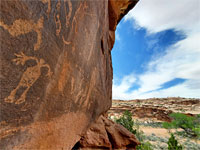Courthouse Wash Rock Art, Arches National Park
Utah > Arches National Park > Hiking > Courthouse Wash Rock Art
Courthouse Wash Rock Art
Large panel of pictographs, and some petroglyphs, in an alcove overlooking the Colorado River, along the south edge of Arches National Park. Damaged and faded, though still impressive
Length: 0.5 miles
Elevation change: 60 feet
Difficulty: Easy
Type: One way
Usage: High
Season: All year
Trailhead: Along US 191, just west of the Colorado River bridge
Rating (1-5): ★★★★★
Elevation change: 60 feet
Difficulty: Easy
Type: One way
Usage: High
Season: All year
Trailhead: Along US 191, just west of the Colorado River bridge
Rating (1-5): ★★★★★
The best and most accessible rock art in Arches National Park is found right at the south edge of the preserve, accessed from US 191, on the north side of Moab - a large panel of intricate, multicolored pictographs plus assorted petroglyphs, viewed by an easy walk of half a mile. The designs are on a southwest-facing cliff of Wingate sandstone overlooking the lower end of a lengthy drainage, Courthouse Wash, where it joins the Colorado River, historically an important location for cross-country travel, beside an ancient fording place of the river.
The designs are difficult to date accurately but are known to have been added in stages, the oldest maybe 4000 years ago, the most recent around the 1500s. The most ancient designs are representative of the Barrier Canyon Style, characterized by large, red, human-like figures with elongated triangular bodies, while the later additions include white shields.
Although partly shielded from rain by a protruding section of the cliff, the rock art does receive direct sunlight in the afternoons and hence is rather faded yet some of the figures remain quite distinctive. The panel was however greatly damaged in 1980, when someone scoured the surface with a wire brush, removing much of the pigment; extensive restoration work followed but inevitably the panel is less spectacular than before.
Arches overview map.
The hike to the Courthouse Wash rock art starts from a parking place on the north side of US 191, along the Moab-Arches cycle route - walking east along this a short distance, across the wash via the road bridge and turning left along a cairned path, which soon splits; the left fork follows the wash upstream, for 5 miles, intersecting the national park scenic drive, while the other path zigzags up stony slopes, briefly quite steep, to the pictographs, at the base of a sheer cliff. Most of the rockface is uneven and weathered but here one section has fallen away to expose a perfectly flat surface, around 15 feet high. The best figures are at the right (south) end, where the rocks above overhang, better protecting the designs from sun and wind. The petroglyphs are found on some of the huge fallen boulders below.
The designs are difficult to date accurately but are known to have been added in stages, the oldest maybe 4000 years ago, the most recent around the 1500s. The most ancient designs are representative of the Barrier Canyon Style, characterized by large, red, human-like figures with elongated triangular bodies, while the later additions include white shields.
Although partly shielded from rain by a protruding section of the cliff, the rock art does receive direct sunlight in the afternoons and hence is rather faded yet some of the figures remain quite distinctive. The panel was however greatly damaged in 1980, when someone scoured the surface with a wire brush, removing much of the pigment; extensive restoration work followed but inevitably the panel is less spectacular than before.
Location
Arches overview map.
Courthouse Wash Rock Art Trail
The hike to the Courthouse Wash rock art starts from a parking place on the north side of US 191, along the Moab-Arches cycle route - walking east along this a short distance, across the wash via the road bridge and turning left along a cairned path, which soon splits; the left fork follows the wash upstream, for 5 miles, intersecting the national park scenic drive, while the other path zigzags up stony slopes, briefly quite steep, to the pictographs, at the base of a sheer cliff. Most of the rockface is uneven and weathered but here one section has fallen away to expose a perfectly flat surface, around 15 feet high. The best figures are at the right (south) end, where the rocks above overhang, better protecting the designs from sun and wind. The petroglyphs are found on some of the huge fallen boulders below.
Courthouse Wash Rock Art - Similar Hikes
All Contents © Copyright The American Southwest | Comments and Questions | Contribute | Affiliate Marketing Disclosure | Site Map
